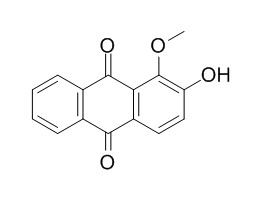2-Hydroxy-1-methoxyanthraquinone
2-Hydroxy-1-methoxy- anthraquinone has antiosteoporotic activity, it can promote osteoblast proliferation, and can inhibit osteoclast TRAP activity and bone resorption.
Inquire / Order:
manager@chemfaces.com
Technical Inquiries:
service@chemfaces.com
Tel:
+86-27-84237783
Fax:
+86-27-84254680
Address:
1 Building, No. 83, CheCheng Rd., Wuhan Economic and Technological Development Zone, Wuhan, Hubei 430056, PRC
Providing storage is as stated on the product vial and the vial is kept tightly sealed, the product can be stored for up to
24 months(2-8C).
Wherever possible, you should prepare and use solutions on the same day. However, if you need to make up stock solutions in advance, we recommend that you store the solution as aliquots in tightly sealed vials at -20C. Generally, these will be useable for up to two weeks. Before use, and prior to opening the vial we recommend that you allow your product to equilibrate to room temperature for at least 1 hour.
Need more advice on solubility, usage and handling? Please email to: service@chemfaces.com
The packaging of the product may have turned upside down during transportation, resulting in the natural compounds adhering to the neck or cap of the vial. take the vial out of its packaging and gently shake to let the compounds fall to the bottom of the vial. for liquid products, centrifuge at 200-500 RPM to gather the liquid at the bottom of the vial. try to avoid loss or contamination during handling.
Drug Test Anal.2018, 10(10):1579-1589
Pharmaceuticals (Basel).2022, 15(8):982.
Proc Biol Sci.2024, 291:20232298.
Asian J Beauty Cosmetol2021, 19(1): 57-64.
Horticulturae2024, 10(4), 382.
Journal of Ginseng Research2019, 10.1016
Separations2021, 8(7),90.
Journal of Applied Biology & Biotechnology2023,11(4):148-158
Foods.2021, 10(11):2627.
Int J Mol Sci.2021, 22(9):5012.
Related and Featured Products
Molecules, 2008, 14(1):573-83.
Antiosteoporotic activity of anthraquinones from Morinda officinalis on osteoblasts and osteoclasts.[Pubmed:
19169204 ]
METHODS AND RESULTS:
Bioactivity-guided fractionation led to the successful isolation of antiosteoporotic components, i.e. physicion (1), rubiadin-1-methyl ether (2), 2-Hydroxy-1-methoxyanthraquinone (3), 1,2-dihydroxy-3-methylanthraquinone (4), 1,3,8-trihydroxy-2-methoxy- anthraquinone (5), 2-hydroxymethyl-3-hydroxyanthraquinone (6), 2-methoxyanthraquinone (7) and scopoletin (8) from an ethanolic extract of the roots of Morinda officinalis. Compounds 4-8 are isolated for the first time from M. officinalis. Among them, compounds 2 and 3 promoted osteoblast proliferation, while compounds 4, 5 increased osteoblast ALP activity. All of the isolated compounds inhibited osteoclast TRAP activity and bone resorption, and the inhibitory effects on osteoclastic bone resorption of compounds 1 and 5 were stronger than that of other compounds.
CONCLUSIONS:
Taken together, antiosteoporotic activity of M. officinalis and its anthraquinones suggest therapeutic potential against osteoporosis.



